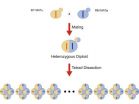(Press-News.org) This press release is available in German.
Silicon nanocrystals have a size of a few nanometers and possess a high luminous potential. Scientists of KIT and the University of Toronto/Canada have now succeeded in manufacturing silicon-based light-emitting diodes (SiLEDs). They are free of heavy metals and can emit light in various colors. The team of chemists, materials researchers, nanoscientists, and opto-electronic experts presents its development in the "Nano Letters" journal (DOI: 10.1021/nl3038689).
Silicon dominates in microelectronics and photovoltaics industry, but has been considered unsuitable for light-emitting diodes for a long time. However, this is not true for nanoscopic dimensions: Minute silicon nanocrystals can produce light. These nanocrystals consist of a few hundred to thousand atoms and have a considerable potential as highly efficient light emitters, as was demonstrated by the team of Professor Uli Lemmer and Professor Annie K. Powell from KIT as well as Professor Geoffrey A. Ozin from the University of Toronto. In a joint project, the scientists have now succeeded in manufacturing highly efficient light-emitting diodes from the silicon nanocrystals.
So far, manufacture of silicon light-emitting diodes has been limited to the red visible spectral range and the near infrared. As regards the efficiency of silicon diodes emitting red light, researchers from Karlsruhe are already top in the world. "Controlled manufacture of diodes emitting multicolor light, however, is an absolutely novelty," explains Florian Maier-Flaig, scientist of the Light Technology Institute (LTI) of KIT and doctoral student of the Karlsruhe School of Optics and Photonics (KSOP). KIT scientists specifically adjust the color of the light emitted by the diodes by separating nanoparticles depending on their size. "Moreover, our light-emitting diodes have a surprising long-term stability that has not been reached before," Maier-Flaig reports. The increased service life of the components in operation is due to the use of nanoparticles of one size only. This enhances the stability of the sensitive thin-film components. Short circuits due to oversized particles are excluded.
The development made by the researchers from Karlsruhe and Toronto is also characterized by an impressing homogeneity of the luminous areas. The KIT researchers are among the few teams in the world that know how to manufacture such devices. "With the liquid-processed silicon LEDs that may potentially be produced on large areas as well as at low costs, the nanoparticle community enters new territory, the associated potentials of which can hardly be estimated today. But presumably, textbooks about semiconductor components have to be rewritten," says Geoffrey A. Ozin, who is presently working as a KIT distinguished research fellow at KIT's Center for Functional Nanostructures (CFN).
The SiLEDs also have the advantage that they do not contain any heavy metals. In contrast to cadmium selenide, cadmium sulfide or lead sulfide used by other groups of researchers, the silicon used by this group for the light-emitting nanoparticles is not toxic. Moreover, it is available at low costs and highly abundant on earth. Due to their many advantages, the SiLEDs will be developed further in cooperation with other partners.
INFORMATION:
Florian Maier-Flaig, Julia Rinck, Moritz Stephan, Tobias Bocksrocker, Michael Bruns, Christian Kübel, Annie K. Powell, Georey A. Ozin, and Uli Lemmer: Multicolor Silicon Light-Emitting Diodes (SiLEDs). In: Nano Letters. DOI: 10.1021/nl3038689
Karlsruhe Institute of Technology (KIT) is a public corporation according to the legislation of the state of Baden-Württemberg. It fulfills the mission of a university and the mission of a national research center of the Helmholtz Association. KIT focuses on a knowledge triangle that links the tasks of research, teaching, and innovation.
This press release is available on the internet at www.kit.edu.
The photo of printing quality may be downloaded under www.kit.edu or requested by mail to presse@kit.edu or phone +49 721 608-4 7414. The photo may be used in the context given above exclusively.
Light from silicon nanocrystal LEDs
2013-02-22
ELSE PRESS RELEASES FROM THIS DATE:
Has evolution given humans unique brain structures?
2013-02-22
Our ancestors evolutionarily split from those of rhesus monkeys about 25 million years ago. Since then, brain areas have been added, have disappeared or have changed in function. This raises the question, 'Has evolution given humans unique brain structures?'. Scientists have entertained the idea before but conclusive evidence was lacking. By combining different research methods, we now have a first piece of evidence that could prove that humans have unique cortical brain networks.
Professor Vanduffel explains: "We did functional brain scans in humans and rhesus monkeys ...
Controversial dam removals founded on value conflicts
2013-02-22
Researchers at Umeå University in Sweden conclude that public opposition to dam removal is not based on knowledge deficiency, as is sometimes argued in dam removal science. It is instead a case of different understandings and valuation of the environment and the functions it provides. The findings are now published in the journal Ecology and Society.
Dam removal is an increasingly common practice as old splash dams and small hydropower dams have become obsolete. Although the removal of these dams has ecological benefits by restoring rivers to their former courses, local ...
Reforming US research ethics: Alex John London calls for system that works for all stakeholders
2013-02-22
PITTSBURGH—At a time when the U.S. government is contemplating changes to federal guidelines governing research with humans, serious questions are being raised about the role of Institutional Review Boards (IRBs) in overseeing such research. Particularly, vocal critics have cited lost time, money and even lives under a system that they claim consumes scarce resources and stifles academic freedom. In response, defenders of the IRB system point to the need to protect research participants from abuse.
Carnegie Mellon University's Alex John London, an internationally renowned ...
Genomic detectives crack the case of the missing heritability
2013-02-22
Despite years of research, the genetic factors behind many human diseases and characteristics remain unknown. The inability to find the complete genetic causes of family traits such as height or the risk of type 2 diabetes has been called the "missing heritability" problem.
A new study by Princeton University researchers, however, suggests that missing heritability may not be missing after all — at least not in yeast cells, which the researchers used as a model for studying the problem. Published in the journal Nature, the results suggest that heritability in humans ...
Researchers find appointed justices outperform elected counterparts
2013-02-22
State supreme court justices who don't face voters are generally more effective than their elected counterparts, according to research led by Princeton University political scientists.
The research combines data about almost 6,000 state supreme court rulings nationwide between 1995 and 1998 with a new theoretical model to reach the conclusions that appointed justices generally bring a higher quality of information to the decision-making process, are more likely to change their preconceived opinions about a case, and are less likely to make errors than elected justices.
"Judges ...
1 week and counting: Don't cut the research that fuels the US economy
2013-02-22
WASHINGTON, DC – With only one week left before sequestration is to take effect, America's research community sustained its call for an end to the across-the-board cuts to discretionary spending that will severely restrict the nation's ability to invest in the basic scientific research that drives innovation and produces economic growth. Sequestration will reduce federal funding for scientific research by nearly $95 billion over the next nine years, which will result in a reduction of U.S. GDP by at least $203 billion. The net impact will be 200,000 fewer jobs per year ...
Israel rocket attacks increase miscarriage likelihood -- Ben-Gurion U. research study
2013-02-22
BEER-SHEVA, Israel, February 21, 2013 -- Rocket attacks in Sderot, Israel significantly increase the likelihood of miscarriages, according to a new study by Ben-Gurion University of the Negev (BGU) researchers.
The study, published in the January issue of Psychosomatic Medicine Journal of Bio-behavioral Medicine, compared 1,341 pregnancies of women (exposed group) who resided in Sderot, an area exposed to frequent rocket fire, with 2,143 pregnancies of women who lived in Kiryat Gat (unexposed group), which is out of range of missiles. Among women residing in the exposed ...
Forecast is for more snow in polar regions, less for the rest of us
2013-02-22
A new climate model predicts an increase in snowfall for the Earth's polar regions and highest altitudes, but an overall drop in snowfall for the globe, as carbon dioxide levels rise over the next century.
The decline in snowfall could spell trouble for regions such as the western United States that rely on snowmelt as a source of fresh water.
The projections are the result of a new climate model developed at the National Oceanic and Atmospheric Administration (NOAA) Geophysical Fluid Dynamics Laboratory (GFDL) and analyzed by scientists at GFDL and Princeton University. ...
The lifetime journeys of manure-based microbes
2013-02-22
This press release is available in Spanish.
Studies at the U.S. Department of Agriculture (USDA) are shedding some light on the microbes that dwell in cattle manure—what they are, where they thrive, where they struggle, and where they can end up.
This research, which is being conducted by Agricultural Research Service (ARS) scientists at the agency's Agroecosystems Management Research Unit in Lincoln, Neb., supports the USDA priority of ensuring food safety. ARS is USDA's chief intramural scientific research agency.
In one project, ARS microbiologist Lisa Durso ...
Catheters linked with high risk of infections, heart problems, and death in dialysis patients
2013-02-22
Highlights
Dialysis patients using catheters to access the blood have the highest risks for death, infections, and cardiovascular events compared with patients using other types of vascular access.
Higher quality studies are needed to determine the true safety of different types of vascular access used for hemodialysis.
Worldwide, more than 1.5 million people are treated with hemodialysis.
Washington, DC (February 21, 2013) — Dialysis patients using catheters to access the blood have the highest risks for death, infections, and cardiovascular events compared with ...



